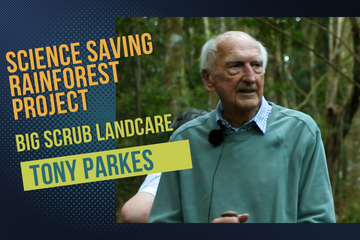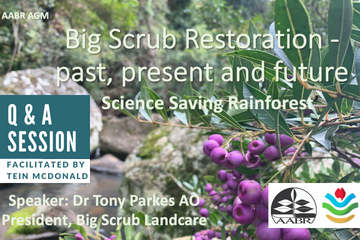The following questions were posed to Dr Tony Parkes at the AABR AGM held 19/2/22. 00:25 Why don’t we value the Big scrub and when do you think it will change? 02:45 Is this work being done elsewhere in the world…The Science Saving Rainforests? 04:45 In the genome project are the species limited to those [...]

Tony Parkes – Science Saving Rainforest Project – Big Scrub Landcare (AABR AGM Guest Speaker)
Suzanne Pritchard2022-03-24T05:56:44+10:00Big Scrub Landcare are now driving an innovative program to ensure that all plantings use genetically diverse planting stock to overcome potential inbreeding and build greater adaptability to climate change within the landscape. Dr Tony Parkes (AO) - retired organic chemist and merchant banker (turned rainforest restorer) - is the Founder and President of Big [...]

Big Scrub Restoration – past, present and future
Suzanne Pritchard2022-03-24T05:58:52+10:00Dr Tein McDonald provides the background to the upcoming AABR Video on Heroes of Big Scrub Recovery and sets the scene for Tony Parkes talk on the Big Scrub Landcare's (BSL) Science Saving Rainforest project. Big Scrub was a once a 75,000 ha swathe of subtropical rainforest on the volcanic soils of the north coast [...]
Big Scrub – making a vision of genetically appropriate seed production areas a reality :: Tony Parkes :: SERA Conference 2018
mitra2020-04-01T20:28:42+10:00Rainforest restoration pioneers, Big Scrub Landcare, are again at the forefront of restoration ecology investigating solutions to the problem of genetic inbreeding in the hundreds of thousands of Big Scrub plantings. With the long term viability of the Big Scrub and associated investment at stake, they have developed a strategy to test for genetic diversity, [...]
Native seed production ‘farming for restoration supply’- Lessons from local and US sectors :: Paul Gibson-Roy :: SERA Conference 2018
mitra2020-04-01T20:28:42+10:00Why is grassy ecosystem restoration so hard…it doesn’t have to be? Paul Gibson-Roy shines the light on the USA’s approach. In 2015 Paul received a Winston Churchill fellowship to explore the industry in the USA .He shares his findings of the scale and viability of the industry and the government incentives and the structures that [...]
Collecting seed and plant production for restoration :: Ross Rapmund, Hornsby Council :: AABR Seminar 2013
mitra2020-07-08T16:10:11+10:00Ross Rapmund provides a clear overview of the production requirements of a community nursery and the role a nursery can play in alleviating the impacts of population fragmentation in the landscape. This snapshot highlights the need for genetic diversity in seed stock, how that diversity is encouraged and the importance of documentation. Topic Mins: [...]
Genetics and Restoration :: Linda Broadhurst and Tein McDonald :: Discussion 2016
mitra2020-07-08T16:30:32+10:00How do you ensure your restoration project will be resilient in times of changing climate and increased fragmentation across the landscape? Tein McDonald discusses with Linda Broadhurst the implications of population size, the parental gene pool and the significance of pollinators in ensuring genetic diversity and countering inbreeding depression. In this expanding field, the importance [...]
Using the Atlas of Living Australia to assist provenance selection for restoration plantings under climate change :: Trevor Booth, CSIRO :: AABR Forum 2016
mitra2020-07-08T16:57:42+10:00How do you work out what plants are suitable to grow in a climate changing world? Trevor Booth outlines a process using readily available web tools, the Atlas of Living Australia along side the Climate change in Australia website, which enables a variety of climate change scenarios to be considered and the location of potential [...]

